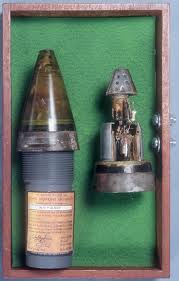
It was at Simmerath, Germany where I first saw the proximity fuse in use by a new type Tank Destroyer. It was larger and distinctly different from any TDs that I had seen. The bogie wheels were larger and evenly spaced. It also mounted a long barreled 90mm gun. Later, I found that this was the M-36 TD.
I was intrigued by the consistent height of the air bursts–all appeared to explode about thirty feet above the ground near the Siegfried Line pillboxes at the base of the slope, about 600 yards from our position. When I asked the gunner how he set his fuses so accurately to get such uniform air-bursts, he replied that a magnet in the shell’s nose caused it to exploded automatically at the desired distance above the ground.
I said that it could not be a magnet–it would have to be done by some type of radio signal. But a radio transceiver (transmitter and receiver) built into an artillery shell — impossible! I had no ready answer and learned only later that my initial assumption had been correct.
Through our binoculars we observed German ambulances making multiple daylight runs to the Siegfried pillboxes at the base of the slope. This appeared suspicious and we thought that they might be bringing in ammunition, food or other supplies in the ambulances, even though this would have been a violation of the Geneva Convention—most German regular army units were usually quite scrupulous in abiding by its dictates. The proximity fuse may well have been the reason for all the ambulance runs that we had observed.
The US began work on the proximity fuse in 1940 and successfully brought it into operation in late 1942. The Germans and British had been working on the fuse for several years, but had failed to develop it. It was first used in the ETO on 12 June 1944 against the buzz-bombs in England and was later in use at Antwerp. US navy gunners had used it against Japanese planes in January 1943, from the USS Helena.
In chapter 4 of “War as I Knew It”, General George Patton stated “the night of December 25 and 2 6 we had used the new proximity fuse on a number of Germans near Echternach and actually killed 700 of them.” This action was during 3rd Army’s move north to Bastogne, and was the first documented use of the fuse against ground forces. It is my belief that we had seen the proximity fuse in use several weeks earlier, even though many WWII authors have stated that it was first used on the continent during the Bulge.
This was well before the Bulge, and should remove all doubt that its use at Simmerath was possible. My belief is reinforced by the explanation of its operation by the gunner, and—although flawed–was a reasonable explanation from an unsophisticated gunner! Because the fuse had been used in England and Antwerp, this Tank Destroyer may have been there and could have carried some proximity rounds to Simmerath. Regardless of how they arrived, I firmly believe they were there and that I had seen the proximity fuse as previously stated!
